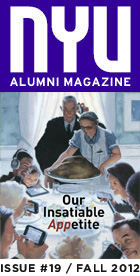alumni profile
Models of the World, Unite!
Ashley Mears / GSAS ’07, ’09
by Alyson Krueger / GSAS ’12
By the time Ashley Mears moved to New York City in 2003, she thought she’d left her modeling years behind. From the age of 16, she had bounced around from high school in suburban Atlanta and college at the University of Georgia to Milan and Tokyo while “pursuing the model dream,” as she calls it. Every young girl thinks she might be the next big thing, Mears says, which keeps one going to endless shoots and casting calls. By 23, she’d had enough.But in her first semester as a graduate student in sociology at NYU, Mears was reading at a Starbucks in Union Square when a scout sat down across from her, told her she had a “great look,” and asked whether she wanted to model. Her initial disinterest quickly gave way to an idea. Researchers had written countless ethnographies after immersing themselves in work at factories or McDonald’s; Mears wondered whether she could do the same with modeling. The new agency agreed to let her take notes on the job and interview clients, agents, and other models. This time she had no illusions of fame or fortune—instead, her goal was academic.
For the next two-and-a-half years, Mears led the restless life of a student-model. She ran from class to photo shoots, studying on the subway or while in line for auditions. The resulting book, Pricing Beauty: The Making of a Fashion Model (University of California Press), provides a pioneering account of how a “look” is chosen, why pay scales vary wildly, and how some girls succeed for the worst reasons. (She asked one casting director why he chose the model that he did. His answer: “I don’t know what to tell you. She reminds me of someone I used to have sex with.”) And because the market has been oversaturated with young hopefuls from around the world who will do anything to strike it big, agents and clients can use models for a short time and then dispose of them with little compensation or thought. “People hadn’t really intellectualized modeling or thought about the economics of this market and the way it can teach us more generally about other kinds of industries,” Mears explains.
Initially, there were skeptics. “I had heard that people in the department were dismissive,” Mears says. “[Modeling] is aligned with superficiality and also with the feminine, which are things that often clash with the ‘serious’ work of academia.” But no one could dismiss the attention the book received. Publishers Weekly called it “a well-researched, well-written, and thorough study of the industry.” Slate proclaimed: “Mears gives voice to a group of women who are paid to be seen and not heard.” And The New Republic conceded, “In ably laying out the evidence, she provides a valuable service.” Mears believes the book helped her to secure a gig writing about Fashion Week for The New York Times and, more important, her current position at Boston University, where she is an assistant professor of sociology. “It’s so secure,” she says. “It’s the complete opposite of being a fashion model.”
Indeed, one of the book’s major revelations was just how poorly models are compensated. A daylong magazine shoot typically pays only $100 (for the cover of Vogue, one may expect an extra $300). Models are often expected to pay their own airfare overseas and, as a result, live under a mounting crush of debt as they pursue their careers. And one can forget about health or retirement benefits.
Former and current models frequently write to Mears, thanking her for shedding light on the industry, and she is helping the nonprofit Model Alliance to advocate for better conditions, such as guaranteeing smoke- and drug-free work environments, and more fair and standardized labor practices, including a private place backstage in which to change and get ready for photo shoots. “I was never very much the advocate,” Mears says, “but if my research can help inform debates that make positive changes, I’m all for that.”
Her scholarly eye is now trained on the international network of model scouts who supply girls to fashion capitals such as New York, Paris, and Tokyo. Mears believes that how these scouts form tastes in beauty—and how that varies around the world—may answer questions about the spread of cultural values. She’s also researching the phenomenon of bottle service at reserved tables in nightclubs. Mears calls the indulgence “a piece of a highly organized nightlife economy,” noting that “women and girls, especially if they look like models, are comped in hopes of luring big-spending men. It is essentially a global market that is run by men and for men, but on women.” Unlike the material for her last book, Mears won’t be conducting fieldwork because individual bottles of alcohol can easily exceed $500 in some clubs. “I don’t think my research account will cover it,” she jokes.







